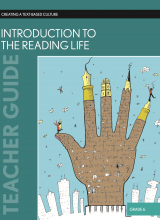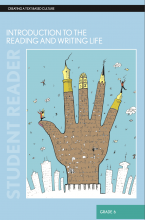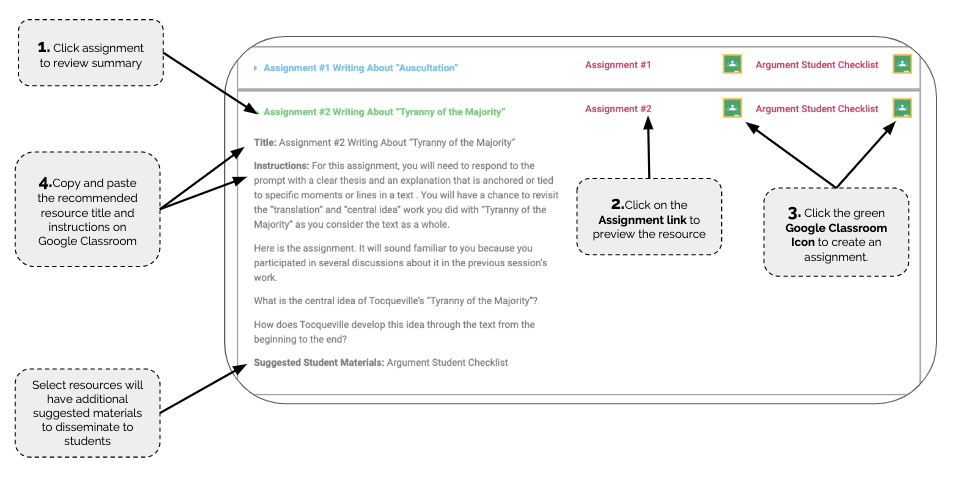Introduction to the Reading Life - Grade 6
Independent reading alone is not sufficient to meet the reading needs many of our students bring to class. Still it must be a significant part of any course of study that aims to help students become better readers. As such, this unit is designed to increase the amount of self-selected independent reading each student does and to support that practice with the direct instruction and modeling needed to increase reading ability and to improve student attitudes toward reading.


Table of Contents
Writing Tasks
Title: Book Interview
Teacher Manual Instructions:
Session 1
Display a copy of the “Book Interview” for the class to see and distribute paper copies to students. (See example nearby or the Appendix for a copy-ready version.)
Using the book you just interviewed, show students how to fill out the sheet.
Pass out three books to each student.
Give students time to make an entry on their “Book Interview” sheet for each of the three titles.
Title: Books I’d Like to Read
Teacher Manual Instructions:
Session 2
Organize students’ desks into one large circle, or two or three smaller circles.
Ask students to get out their notebooks.
Explain that the writer’s notebook will play an important role in their reading work and that writers often use their notebook to reflect on and track elements of their reading life as well.
Ask students to turn to the next blank page in their notebook.
Ask students to place the following heading at the top of that page: “Books I’d Like to Read.” Remind them to add this entry to the table of contents as well. Model this using your own notebook. Use the example above as a guide.
Explain that this page is the place where you write down books that you want to be sure to read. In short, it’s a remembering tool or a decision-making tool.
“Book Interview” forms students completed during the last session back to the class. Give students a moment to review these and, if they interviewed a book they think they might like to read, to enter it on the list.
Title: Book Pass
Teacher Manual Instructions:
Session 2
• Explain the purpose of a book pass:
» A book pass is another way to expose students to the texts available to them in the classroom library. A book pass requires students to use their book interviewing skills. A book pass is a chance for students to find titles to add to their “Books I’d Like to Read” list.
Distribute copies of the “Book Pass” sheet to students. (A copy-ready version can be found in the Appendix.)
Be sure you have one title for each student in the circle.
Give each student one book (or magazine). Tell students it doesn’t matter what they start with, because they will see all the books.
Choose a direction for passing.
After students receive a book, they should immediately record the author’s name (if the text is a book) and title on the “Book Pass” sheet.
Give students one minute to interview each book following the procedure established in the previous session.
At the end of one minute, call “pass.” At this time, students should make an entry in the comments column and pass the book to the next student.
Continue the book pass until each student has interviewed all the books.
Title: Goals for My Reading Life
Teacher Manual Instructions:
Session 14
Ask students to turn to the “Books I’d Like to Read” page in their notebooks.
Display a copy of “Goals for My Reading Life” for the class to see and distribute copies to students. Using the display copy, show students how to fill out the goals sheet. Show them how they can use the information charts created in earlier sessions to generate ideas for answers to the “Goals” questions.
Explain that at the beginning of each six weeks, each student will fill out
a new goals sheet. At the end of each six weeks, students will take a few minutes to review their goals statements and reflect on their efforts to meet them.Answer any questions students have about the “Goals for My Reading Life.”
Give students time to complete the sheet. (They should only fill out the goal-setting portion of the assessment at this point.) Tell them that these will be collected at the end of the closing meeting and that you will return these at the next session. (You may decide to photocopy a set for yourself.)
Return the sheets to students during the next session and have them attach the sheet to a page in their notebook.
Title: Reading Log
Teacher Manual Instructions:
Session 15
Write “Reading Log” on the board.
Explain to the class that a reading log is simply a place where a reader keeps track of all the reading he or she has done over a period of time.
Ask students to turn to the next blank page in their notebooks and to reserve at least three pages for the reading log.
On a piece of chart paper or another display, show students how to set up a “Reading Log” in their writer’s notebook. (See example on next page.) They should be sure to enter it in their table of contents as well. You may decide to distribute sticky notes so that students can flag this page.
Explain to students that they should make an entry in their log only after they have finished a book. You will need to negotiate with students how to handle the entry of magazine readings (for example, entire issues versus individual articles).
After students have set up the log, including proper headings, creating the grid, etc., show students how to make an entry.
Answer any questions students have about the reading log.
Tell students that they can make their first entry in their reading log at the beginning of independent reading.
Charts for Discussion
Title: Taking Care of Books
Teacher Manual Instructions:
Session 4
Book care: Create a chart titled “Taking Care of Books.” Because many of the books in the library are paperbacks, without proper care they will soon fall into disrepair. Students should be taught basic, common-sense lessons about book care, including picking books up when they’ve been dropped or found on the floor; caring for book bindings (for example, don’t fold books back or leave them splayed open on a desk—use a bookmark instead); don’t throw or toss books; etc. Take a minute to add items to the “Taking Care of Books” chart.
Title: Reasons for Independent Reading
Teacher Manual Instructions:
Session 5
Point out that independent reading accounts for approximately 40 percent of the reading time. There is a reason for this. Create a chart titled “Reasons for Independent Reading.”
Title: Rules for Independent Reading
Teacher Manual Instructions:
Session 5
Create a chart titled “Rules for Independent Reading.” Collaborate with the class to generate a short list of rules for independent reading time. Your list should include
Read silently.
Stay seated (there should be no moving around the room).
No talking (except for “whispering conversations” or “conferences” between a teacher and a student).
Everybody reads the whole time.
Title: Readers Monitor for Meaning
Teacher Manual Instructions:
Session 6
Explain to the class that the number one thing that separates a good reader from a novice is that the proficient reader knows when he or she stops “getting it”—in other words, a good reader monitors for meaning.
Collaborate with students to create a chart like the one shown on page 32 of the teacher manual.
Tell students that over the next couple of sessions the class will consider a few more ways to solve problems that arise during reading.
Title: Handling Unfamiliar Words
Teacher Manual Instructions:
Session 7
Explain to the class that today you want to talk about one particular problem—what to do with unfamiliar words.
Create a chart titled “Handling Unfamiliar Words.”
Ask students what they do when they encounter a difficult word.
Get these items down on the chart.
Be sure to point out to students the difference between words you don’t recognize and words you simply don’t know. For example, “sound out the word” might be on the “Handling Unfamiliar Words” chart. Sounding out a word can be helpful if you already know the word, but just didn’t recognize it. You might say it all the time, but simply not know it by sight. But does sounding out a word help when you simply don’t know the word? What do you do then?
Title: What Do I Do When I Lose Track of What’s Going On?
Teacher Manual Instructions:
Session 8
This focus lesson concentrates on questions a reader asks before reading to prevent “losing track” and questions a reader asks during reading to start “getting it” again.
Direct students’ attention to the chart titled “What Do I Do When I Lose Track of What’s Going On?” or distribute individual copies to students.
Ask the class what the difference is between a story and an informational text. Remind students that there are fiction and nonfiction stories. Ask students to use their own independent reading texts to give examples of stories and informational pieces.
Once the differences between story and informational text have been established, ask students to look at the “Before/Story” section of the chart. Ask students whether they think about these things as you begin each day’s shared reading (or, if you ask these questions before reading already, ask students if the questions sound familiar). Remind them that the whole point of asking these questions before reading is to prevent confusion from setting in.
Briefly, use a non-narrative informational text (such as a feature article from Muse or another magazine) to model the “before” process using the informational text questions.
Introduce the “during” questions as well. Use the shared reading time to model the use of these questions for story, as well as the habits of stopping, thinking, questioning, and rereading.
Title: The Habits of Lifelong Readers
Teacher Manual Instructions:
Session 9
Remind students that over the last several sessions, they have learned much about the reading life.
Explain that this session’s focus lesson is an opportunity to distill this learning—to make it more memorable.
Create a chart titled “The Habits of Lifelong Readers.”
Ask students to take a minute to scan the information charts created in previous sessions. (They won’t need the rules charts here.)
Next, ask students to help you fill in the “Habits of Lifelong Readers” chart.
- Chart items should include the list in Session 9 of the teacher manual.
Title: Expectations for Independent Reading
Teacher Manual Instructions:
Session 13
Ask students to help you create a list of all of the things they have been taught and learned about reading over the last several sessions.
When you have some items recorded, explain to students that during this focus lesson you will create a chart where you make clear and visible your expectations for independent reading. This chart is an answer to the question: “What does a healthy, vigorous independent reading life look like in this classroom?”
Direct students’ attention to the “Expectations for Independent Reading” chart or distribute individual copies to the class.
Ask for volunteers to read the items on the list aloud to the rest of the class. Tell students you will help them set up a reading log to track their reading.
Tell students that at the end of the unit, they will set goals for their own independent reading and writing this year. Every couple of weeks they will do a self-assessment where they reflect on their progress in meeting those goals. The “Expectations” chart will help students formulate their goals and articulate their self-assessments.
Independent Reading
Title: Book Interview
Instructions:
Display a copy of the “Book Interview” for the class to see and distribute paper copies to students. (See example nearby or the Appendix for a copy-ready version.)
Using the book you just interviewed, show students how to fill out the sheet.
Pass out three books to each student.
Give students time to make an entry on their “Book Interview” sheet for each of the three titles.
Title: Books I’d Like to Read
Teacher Manual Instructions:
Organize students’ desks into one large circle, or two or three smaller circles.
Ask students to get out their notebooks.
Explain that the writer’s notebook will play an important role in their reading work and that writers often use their notebook to reflect on and track elements of their reading life as well.
Ask students to turn to the next blank page in their notebook.
Ask students to place the following heading at the top of that page: “Books I’d Like to Read.” Remind them to add this entry to the table of contents as well. Model this using your own notebook. Use the example above as a guide.
Explain that this page is the place where you write down books that you want to be sure to read. In short, it’s a remembering tool or a decision-making tool.
“Book Interview” forms students completed during the last session back to the class. Give students a moment to review these and, if they interviewed a book they think they might like to read, to enter it on the list.
Title: Book Pass
Teacher Manual Instructions:
• Explain the purpose of a book pass:
» A book pass is another way to expose students to the texts available to them in the classroom library. A book pass requires students to use their book interviewing skills. A book pass is a chance for students to find titles to add to their “Books I’d Like to Read” list.
Distribute copies of the “Book Pass” sheet to students. (A copy-ready version can be found in the Appendix.)
Be sure you have one title for each student in the circle.
Give each student one book (or magazine). Tell students it doesn’t matter what they start with, because they will see all the books.
Choose a direction for passing.
After students receive a book, they should immediately record the author’s name (if the text is a book) and title on the “Book Pass” sheet.
Give students one minute to interview each book following the procedure established in the previous session.
At the end of one minute, call “pass.” At this time, students should make an entry in the comments column and pass the book to the next student.
Continue the book pass until each student has interviewed all the books.
Title: Goals for My Reading Life
Teacher Manual Instructions:
Ask students to turn to the “Books I’d Like to Read” page in their notebooks.
Display a copy of “Goals for My Reading Life” for the class to see and distribute copies to students. Using the display copy, show students how to fill out the goals sheet. Show them how they can use the information charts created in earlier sessions to generate ideas for answers to the “Goals” questions.
Explain that at the beginning of each six weeks, each student will fill out
a new goals sheet. At the end of each six weeks, students will take a few minutes to review their goals statements and reflect on their efforts to meet them.Answer any questions students have about the “Goals for My Reading Life.”
Give students time to complete the sheet. (They should only fill out the goal-setting portion of the assessment at this point.) Tell them that these will be collected at the end of the closing meeting and that you will return these at the next session. (You may decide to photocopy a set for yourself.)
Return the sheets to students during the next session and have them attach the sheet to a page in their notebook.
Title: Reading Log
Teacher Manual Instructions:
Write “Reading Log” on the board.
Explain to the class that a reading log is simply a place where a reader keeps track of all the reading he or she has done over a period of time.
Ask students to turn to the next blank page in their notebooks and to reserve at least three pages for the reading log.
On a piece of chart paper or another display, show students how to set up a “Reading Log” in their writer’s notebook. (See example on next page.) They should be sure to enter it in their table of contents as well. You may decide to distribute sticky notes so that students can flag this page.
Explain to students that they should make an entry in their log only after they have finished a book. You will need to negotiate with students how to handle the entry of magazine readings (for example, entire issues versus individual articles).
After students have set up the log, including proper headings, creating the grid, etc., show students how to make an entry.
Answer any questions students have about the reading log.
Tell students that they can make their first entry in their reading log at the beginning of independent reading.
Unit Resources
Title: What Do I Do When I Lose Track of What’s Going On?
